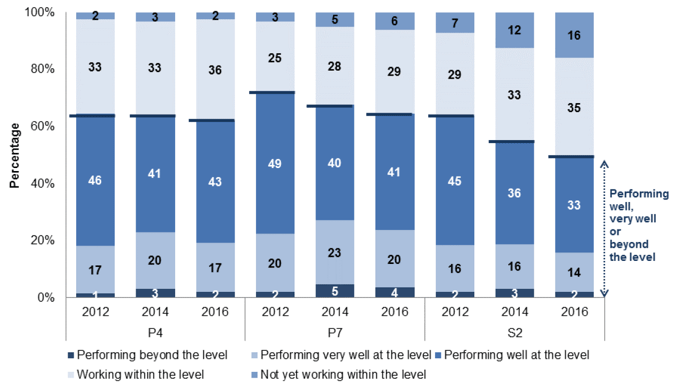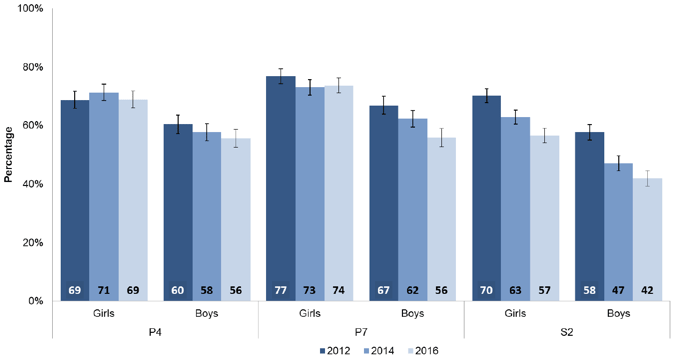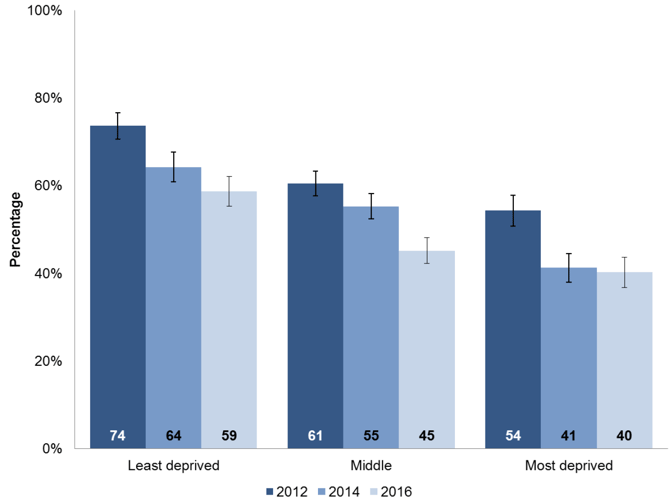Scottish Survey of Literacy and Numeracy 2016: literacy
Literacy results from the 2016 survey which covers assessment of school pupils at various stages in primary and secondary school.
Chapter 5: Writing attainment over time
- Writing performance of P4 pupils was similar in 2016 and 2012. Performance of P7 and S2 pupils declined by seven and 15 percentage points respectively, between 2012 and 2016.
- Girls outperformed boys in writing at all stages, in all three literacy surveys. The gender gap in P7 increased between 2012 and 2016. It was unchanged at P4 and S2.
- Pupils from the least deprived areas outperformed pupils from the most deprived areas in writing at all stages in all three surveys. The size of the gap in performance in 2016 was similar to the size of the gap in 2012.
A key objective of the SSLN is to monitor national performance over time in all aspects of literacy, at P4, P7 and S2. This chapter provides key trends in writing over the three literacy surveys (2012, 2014, 2016).
5.1 Writing attainment over time
Chart 5.1 shows writing performance by reporting categories and stage, over the three literacy surveys: 2012, 2014 and 2016.
Chart 5.1: Proportion of writing scripts in each reporting category by stage, 2012, 2014 and 2016

The time series trend varies between stages, Table 5.1 shows which changes over time are statistically significant.
Table 5.1: Difference in proportion of pupils performing well, very well or beyond the level in 2012, 2014 and 2016, by stage
| Stage |
2012 to 2014 |
2014 to 2016 |
2012 to 2016 |
|---|---|---|---|
| P4 |
No difference |
No difference |
No difference |
| P7 |
Lower in 2014 |
Lower in 2016 |
Lower in 2016 |
| S2 |
Lower in 2014 |
Lower in 2016 |
Lower in 2016 |
The proportion of P4 scripts that show pupils performing well, very well or beyond the level has stayed constant over the three surveys. The small reduction of two percentage points between 2012 and 2016 is not statistically significant.
In contrast, there has been a decline of seven percentage points in performance for P7 from 72 to 65 per cent between 2012 and 2016. In particular, the proportion performing well fell by eight percentage points, very well stayed the same and those performing beyond the level rose two percentage points.
There was also a decline in S2 scripts that demonstrate pupils performing well, very well or beyond the level from 64 per cent in 2012 to 49 per cent in 2016. The proportion of scripts which were assessed as performing well dropped 12 percentage points, very well dropped by three points and beyond the level stayed the same.
The proportion of S2 scripts assessed as not yet working at the level rose from seven per cent in 2012 to 16 per cent in 2016. For S2 it is the rise in the proportion marked not yet working at the level that explains the larger share of the decline in performance.
5.2 Attainment by gender
The pattern of performance by gender over time varied between stages, with only some changes in performance being statistically significant. These changes are displayed in Table 5.2.
Table 5.2: Difference in proportion of pupils performing well, very well or beyond the level in 2012, 2014 and 2016, by stage and gender
Girls
| Stage |
2012 to 2014 |
2014 to 2016 |
2012 to 2016 |
|---|---|---|---|
| P4 |
No difference |
No difference |
No difference |
| P7 |
Lower in 2014 |
No difference |
No difference |
| S2 |
Lower in 2014 |
Lower in 2016 |
Lower in 2016 |
Boys
| Stage |
2012 to 2014 |
2014 to 2016 |
2012 to 2016 |
|---|---|---|---|
| P4 |
No difference |
No difference |
Lower in 2016 |
| P7 |
Lower in 2014 |
Lower in 2016 |
Lower in 2016 |
| S2 |
Lower in 2014 |
Lower in 2016 |
Lower in 2016 |
Girls' performance in P4 and P7 varied little from 2012 to 2016. In S2, however, the proportion of scripts assessed as performing well, very well or beyond the level fell from 70 per cent in 2012 to 57 per cent in 2016.
On the other hand, performance for boys declined across all stages between 2012 and 2016. The size of the declines varied at each stage. For P4 the performance of boys declined five percentage points between 2012 and 2016 (from 60 to 56 per cent (difference due to rounding)). For P7 boys, there was an 11 per cent fall (from 67 to 56 per cent) and S2 boys a 16 per cent fall (from 58 to 42 per cent).
Chart 5.2: Proportion of writing scripts demonstrating pupils performing well, very well or beyond the level, by gender and stage, 2012, 2014 and 2016

Throughout all years of the survey and across all stages girls perform better than boys in writing. The degree to which girls have outperformed boys has increased at P7 (no change at P4 or S2). This increase is mostly explained by declining performance for boys rather than changes in girls' performance.
5.3 Attainment by deprivation
The pattern of performance by deprivation over time is stable, in that a performance gap continues to exist across all stages.
Changes in performance of pupils within each deprivation category varied between stages, with only some changes in performance being statistically significant between the three surveys. These changes are displayed in Table 5.3.
Table 5.3: Difference in proportion of pupils performing well, very well or beyond the level in 2012, 2014 and 2016, by stage and deprivation
Least deprived category (pupils from the least deprived 30% of datazones)
| Stage |
2012 to 2014 |
2014 to 2016 |
2012 to 2016 |
|---|---|---|---|
| P4 |
Lower in 2014 |
No difference |
No difference |
| P7 |
No difference |
No difference |
Lower in 2016 |
| S2 |
Lower in 2014 |
Lower in 2016 |
Lower in 2016 |
Middle deprivation category (pupils from the middle 40% of datazones)
| Stage |
2012 to 2014 |
2014 to 2016 |
2012 to 2016 |
|---|---|---|---|
| P4 |
No difference |
No difference |
No difference |
| P7 |
No difference |
No difference |
Lower in 2016 |
| S2 |
Lower in 2014 |
Lower in 2016 |
Lower in 2016 |
Most deprived category (pupils from the most deprived 30% of datazones)
| Stage |
2012 to 2014 |
2014 to 2016 |
2012 to 2016 |
|---|---|---|---|
| P4 |
Higher in 2014 |
Lower in 2016 |
No difference |
| P7 |
No difference |
No difference |
Lower in 2016 |
| S2 |
Lower in 2014 |
No difference |
Lower in 2016 |
In P4 there was no statistically significant difference in performance between 2012 and 2016. In particular, for the least deprived category, although there was a statistically significant fall between 2012 and 2014 this is offset by a small (and itself statistically insignificant) rise between 2014 and 2016. Amongst the most deprived, performance rose from 54 per cent in 2012 to 60 per cent in 2014 but then fell back to 54 per cent in 2016.
The overall results for P7 showed a decrease between 2012 and 2016. This change was reflected throughout all the deprivation categories as performance in the least deprived, middle and most deprived categories decreased by seven, six and nine percentage points respectively.
Similarly, the overall results for S2 showed a decrease between 2012 and 2016 (Chart 5.3). This change was reflected throughout all the deprivation categories as performance in the least deprived, middle and most deprived categories decreased by 15, 15 and 14 percentage points respectively.
Chart 5.3: Proportion of S2 writing scripts demonstrating pupils performing well, very well or beyond the level, by deprivation category and stage, 2012, 2014 and 2016

Table 5.4 shows the size of the gap between performance of those in the least and most deprived categories and the results of significance tests on the change in this gap.
Table 5.4: Difference in writing performance by deprivation category in 2012, 2014 and 2016, by stage
Deprivation gap (least deprived minus most deprived), percentage points
| Stage |
2012 |
2014 |
2016 |
|---|---|---|---|
| P4 |
19 |
6 |
15 |
| P7 |
18 |
20 |
20 |
| S2 |
19 |
23 |
18 |
Change in deprivation gap
| Stage |
2012 to 2014 |
2014 to 2016 |
2012 to 2016 |
|---|---|---|---|
| P4 |
Smaller in 2014 |
Larger in 2016 |
No difference |
| P7 |
No difference |
No difference |
No difference |
| S2 |
No difference |
No difference |
No difference |
The deprivation gap in writing attainment did not change significantly between 2012 and 2016 at any stage. Pupils in the least deprived category performed between 15 and 20 percentage points better than their peers in the most deprived category.
Among P4 pupils, the deprivation gap closed from 19 percentage points in 2012 to six percentage points in 2014 before widening to 15 percentage points in 2016. The differing underlying trends in performance of pupils in the least and most deprived categories need to be appreciated when considering these changes. Performance of P4 pupils in the least deprived category was 73 per cent in 2012, 66 per cent in 2014 and finally 69 per cent in 2016. The equivalent figures for the most deprived were 54, 60 and 54 per cent. The small deprivation gap in 2014 is reflective of the best performance of the most deprived P4 pupils found during the survey period coinciding with the weakest performance of the least deprived P4 pupils.
Contact
Email: Marion MacRury
Phone: 0300 244 4000 – Central Enquiry Unit
The Scottish Government
St Andrew's House
Regent Road
Edinburgh
EH1 3DG
There is a problem
Thanks for your feedback